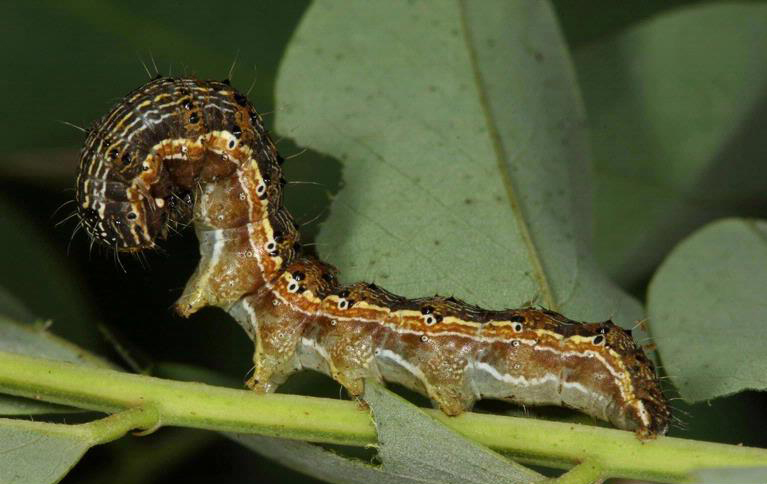
This love story between two invasive pests is set in the southern states, but most notably Texas. The cotton bollworm entered from Mexico around 1916 and within 20 years had spread to over 119 counties within Texas, infuriating farmers along the way. The adult is a small moth, but before reaching maturity it goes through three other stages of development: egg, larva, and pupa. The larvae have been described as being aggressive, occasionally carnivorous and are reported to even cannibalize each other. During the destructive larval stage it eats the maturing seeds within the cotton boll.
In the 1960s and 1970s chemical insecticides, including DDT, were used in an attempt to control their spread. The following decade ushered in a heightened interest in nonchemical pest control. After experimenting with hormone manipulation, the Texas Department of Agriculture came up with a romantic solution. Through the use of insect pheromones, researchers tricked male bollworms into mating with female budworms (another invasive pest). Since the different species had mismatched genitalia, upon mating the insects became locked together and died. Happy Valentine's Day!
In the 1960s and 1970s chemical insecticides, including DDT, were used in an attempt to control their spread. The following decade ushered in a heightened interest in nonchemical pest control. After experimenting with hormone manipulation, the Texas Department of Agriculture came up with a romantic solution. Through the use of insect pheromones, researchers tricked male bollworms into mating with female budworms (another invasive pest). Since the different species had mismatched genitalia, upon mating the insects became locked together and died. Happy Valentine's Day!


 It's the time of year when ladybugs start to emerge. If you look closely, you might notice something odd once in a while when you come across one that is spotless. Have no fear, this isn't some strangely packaged omen. They are commonly known as polished ladybugs or Cycloneda munda. Either that or it's just a normal ladybug that happens to have no spots.
It's the time of year when ladybugs start to emerge. If you look closely, you might notice something odd once in a while when you come across one that is spotless. Have no fear, this isn't some strangely packaged omen. They are commonly known as polished ladybugs or Cycloneda munda. Either that or it's just a normal ladybug that happens to have no spots. Every year 300 snails compete in the annual World Snail Racing Championship, held in Congham, Norfolk. The snails race from the middle of a circle (radius = 13 inches) to the outside. The snails are put in the center and pointed in the right direction, as their Trainer starts the race by yelling "Ready, steady, SLOW!"
Every year 300 snails compete in the annual World Snail Racing Championship, held in Congham, Norfolk. The snails race from the middle of a circle (radius = 13 inches) to the outside. The snails are put in the center and pointed in the right direction, as their Trainer starts the race by yelling "Ready, steady, SLOW!"
 This mythical black-winged and orange bodied moth is so rare that it has been found on only four previous occasions since 1853. Until very recently near Loch Morie, Easter Ross, Highland in Scotland. While walking through the forest, Andy Scott and Margaret Currie noticed it in a spider's web and rescued it from certain doom.
This mythical black-winged and orange bodied moth is so rare that it has been found on only four previous occasions since 1853. Until very recently near Loch Morie, Easter Ross, Highland in Scotland. While walking through the forest, Andy Scott and Margaret Currie noticed it in a spider's web and rescued it from certain doom.
